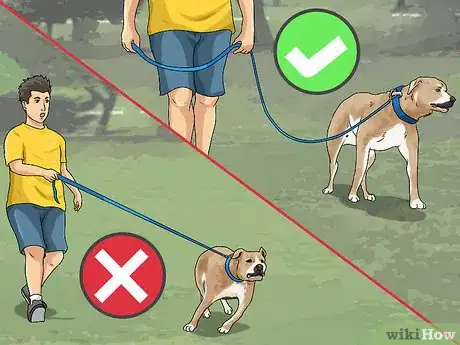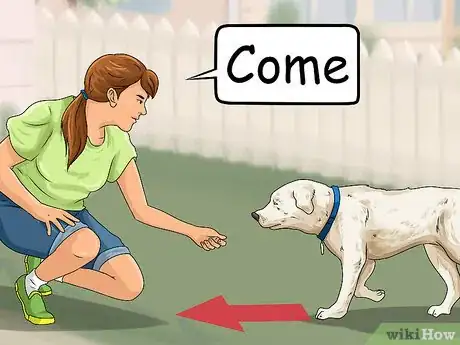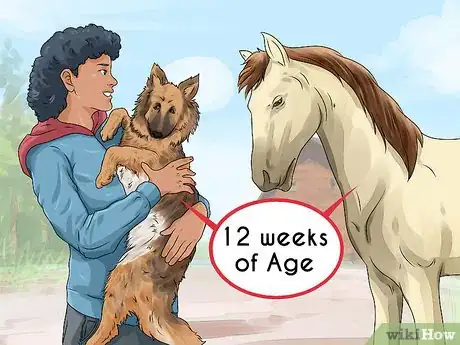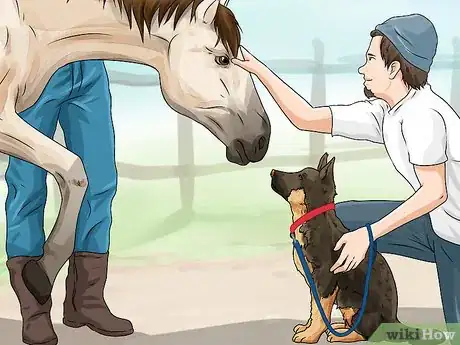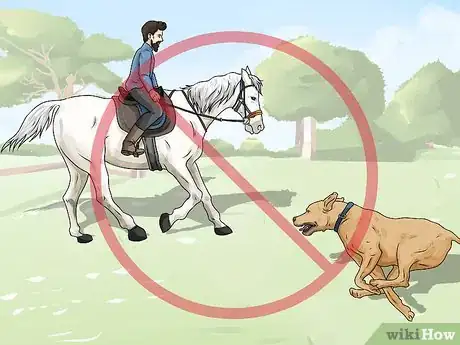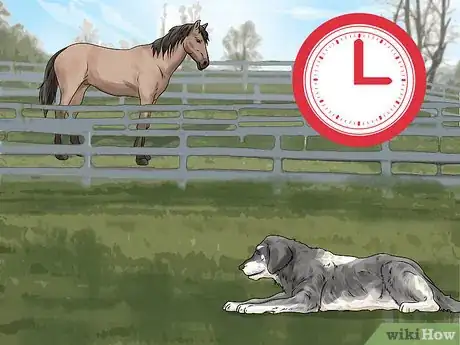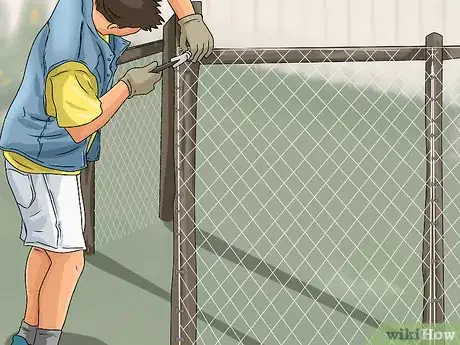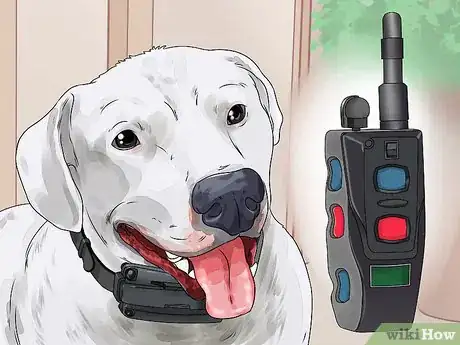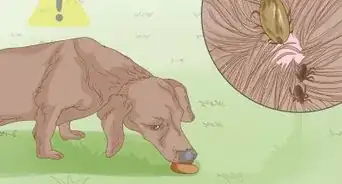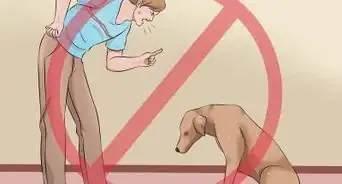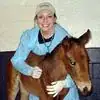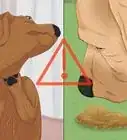This article was co-authored by Ryan Corrigan, LVT, VTS-EVN. Ryan Corrigan is a Licensed Veterinary Technician in California. She received her Bachelor of Science in Veterinary Technology from Purdue University in 2010. She is also a Member of the Academy of Equine Veterinary Nursing Technicians since 2011.
There are 9 references cited in this article, which can be found at the bottom of the page.
This article has been viewed 24,445 times.
Many species of dog are bred to chase large animals. It can be dangerous, however, for your dog to chase horses. You need to teach your dog to stay away from riding areas and to obey commands near horses. However, this doesn’t mean keeping your dog away from horses. You should try to introduce your dog to horses so that it does not get anxious around them and become uncontrollable.
Steps
Training Your Dog
-
1Teach your dog to sit. Before you introduce your dog and horse you need to be sure that you have taught your dog the basic commands, like sitting, that would allow you to keep them safely under control. Get on your puppy’s level. Hold a treat close to its nose and move the treat up so that your dog begins to lower its butt. Once its butt hits the floor give it the treat.[1]
- Tell your dog to “sit” while your dog moves its butt to the ground. Eventually it will come to associate the action with your command.
- When your dog’s butt hits the ground, give it the treat. If you have a clicker, make a clicking sound as you feed your dog its treat. Once your dog associates the click with the treat, it will perceive the clicking sound as its own reward.
- Praise your dog when it sits. Speak in a positive tone and pet it.
- Repeat this trick several times a day, every day, for a week, then periodically thereafter.
-
2Train your dog for loose leash walking. Your need to be able to control your dog when it is on its leash. Never allow it to pull you forward with its leash. When it begins pulling stop and command it to sit.[2]
- After getting your dog to sit, consider walking in the opposite direction. Over time, your dog should learn that rushing ahead of you will only slow it down.
Advertisement -
3Teach your dog the command “come.” When your dog is several feet, offer and a treat or a toy and command it to “come.” Do this on a regular basis until it responds to the command “come” without you offering a treat. If your dog knows this command, you can call it back from a dangerous situation.
- You don’t want to build negative associations with the command “come.” If you tell your dog to “come” and then scold it or do something--like give it a bath--that it doesn’t like, then it will be less prone to respond to “come” in the future. This can undermine your training and make it more difficult to control your dog in a dangerous situation.[3]
-
4Practice your commands near horses. Practice the commands “sit” and “come” near a horse while keeping your dog on a leash. Give your dog a treat every time that it executes commands successfully. Don’t punish your dog if it fails. It will probably take several sessions of progressively more demanding training for you to establish control over your dog when horses are around.
- Sessions should be no longer than 15 minutes, so that your dog does not get tired.
- Start far away from the horse. Each time your dog has a successful session, move closer for the next one. Eventually try to perform commands when someone is riding the horse, because this is when the dog’s hunting instincts will be most likely to kick in.
- If your dog repeatedly gets distracted or fails to follow commands, take a break and try again in a few hours.
Introducing Your Horse and Dog
-
1Try to introduce your animals when they are young. Horses and dogs both reach peak socialization at around 12 weeks of age. It is during that period that you are most likely to be able to make them comfortable with each other. Don’t, however, let the animals run loose around each other at this age.
- It is particularly dangerous to let a puppy run loose around a horse. The puppy might startle the horse and get kicked. Hold the puppy closely and introduce them in a controlled manner, until they are trained and responsible.
-
2Let them see each other from a distance. Before you introduce your animals, give them time to acclimate to each other from a distance. With your dog on a leash, stand about 50 feet (15 m) away from the horse. Act as if nothing unusual is happening.[4]
- If your dog barks or runs after the horse, tell your dog to sit and be quiet. Use your commands to keep your dog under control. Reward your dog when it sits quietly.
- Do not allow your dog near your horse until it can interact calmly with the horse from a distance.
-
3Bring your dog to the barn. Bring your dog around the barn every day as you go through your routine. Get your dog acclimated to spending time near the horse. While in the barn, introduce your dog to the smell of the horse.
- In the barn, allow your dog to smell the horse’s halter, headstall, or saddle blanket. Introducing your dog to the smell of the horse will put it at ease when the two are finally introduced.[5]
-
4Introduce your dog and horse in a controlled environment. Outside of the barn, allow your dog and horse to approach each other, but be sure that both are firmly restrained. Allow them to smell each other.
- If your dog begins to get aggressive—biting, barking, or growling—firmly correct it and separate the two briefly. Wait for about a minute and then allow them to approach each other again.
- Your dog should be on a leash for this encounter. Your horse should be controlled by an experienced handler.[6]
-
5Teach your dog to stay away from riding areas. If your dog comes to believe that areas where your horse runs quickly are safe, it will be likely to rush into a dangerous situation. Anytime your dog begins approaching a riding area tell it “no” and command it to “sit” or “come.”
- For practice, try walking around the riding area with your dog on a leash. If it begins heading to the riding area tell it “no,” then command it to “sit” and have it come back to you.[7]
-
6Give your animals time to become disinterested in each other. Ideally, your dog and horse won’t notice each other or pay the other much attention. The best way to accomplish this is to continue to allow them to see each other from a distance. Your dog should be near the barn on a regular basis, but never in a riding area.
- It might take several months for your dog and horse to reach this level of comfort. Until then, ensure that they are physically separated or under constant supervision when they are together.[8]
Protecting a Dog Who Refuses to Be Trained
-
1Build a fence. The best way to ensure that your dog stays away from your horse is to fence them off from each other. Many retailers sell fences that are specifically designed for horses. It is important to use these, because they are designed to be visible to the horse and protect the horse if it collides with the fence.[9]
-
2Buy a shock collar. A shock collar will allow you to send a mild electric shock to your dog when it begins behaving badly. Usually a few shocks will be enough to teach a dog not to engage in bad behavior. Shock your dog when it begins approached the horse’s riding area. This method will cause pain, but it is not dangerous.[10]
-
3Hire a professional dog trainer. Professional trainers are familiar with advanced dog training techniques that you might have trouble employing. A well-trained dog even run safely alongside a horse. However, this requires that the dog be taught a variety of signs and be taught to keep a certain distance from the horse. It is dangerous for an amateur to try to teach these sort of techniques.[11]
- For advanced skills, like teaching a dog to run safely near the horse, you will need to find a trainer who also works with horses and is thus qualified to teach both animals to work together.
- Several sessions with a dog trainer might cost between $300 to $600.[12]
References
- ↑ http://www.nylabone.com/mobile/dog-101/training-behaviors/obedience-training.htm
- ↑ http://www.nylabone.com/mobile/dog-101/training-behaviors/obedience-training.htm
- ↑ https://www.petfinder.com/dogs/dog-training/teaching-dog-come-when-called/
- ↑ http://www.thehorse.com/articles/10967/dogs-and-horses-predators-and-prey
- ↑ http://horseandrider.com/article/introduce_dog_horses_092409-13051
- ↑ http://horseandrider.com/article/introduce_dog_horses_092409-13051
- ↑ http://horseandrider.com/article/introduce_dog_horses_092409-13051
- ↑ http://www.thehorse.com/articles/10967/dogs-and-horses-predators-and-prey
- ↑ http://extension.psu.edu/animals/equine/horse-facilities/fence-planning-horses
About This Article
To keep your dog from chasing horses, let it smell the horse’s halter or saddle before you introduce the animals so it gets used to the horse’s smell. Next, let them see each other from a distance so they can slowly get acclimated to each other. When you introduce them, keep your dog on a leash, and have someone else hold the horse. That way, you can separate them immediately if your dog starts barking or biting. Even if they're getting along, continue supervising the animals when they're together, since it can take several months for them to lose interest in each other. For tips from our Veterinary co-author on how to train your dog, read on!

